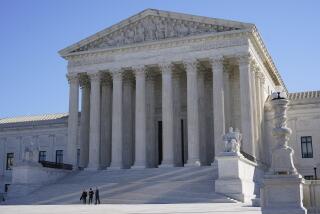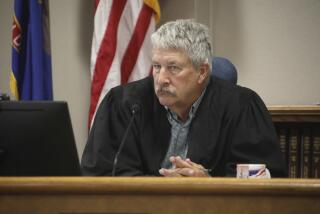Midterm Abortions Argued in High Court
- Share via
WASHINGTON — The Supreme Court justices, hearing their first abortion case in eight years, argued the question Tuesday of whether doctors or state legislators should have the final word on how midterm abortions are to be performed.
Most of the justices took the doctors’ side and suggested state laws banning “partial-birth” abortions go too far by prohibiting what some medical experts say is the safer method of performing these abortions.
With abortion opponents and defenders chanting outside in a pouring rain, the justices observed that the bans would force doctors to use a riskier surgical technique that could cause bleeding and infections in some patients.
Four justices are strong supporters of abortion rights, and they were joined by Justice Sandra Day O’Connor in questioning the prohibitions.
“There is no exception [in the law] for the health of the mother, is there?” O’Connor asked Nebraska Atty. Gen. Donald Stenberg, who was defending his state’s law.
No, he replied, saying an exception allowing doctors to perform the banned procedure to protect a mother’s health was not necessary because other similar abortion procedures are legal in Nebraska.
Obviously unswayed, O’Connor said the other procedures for performing midterm abortions are quite similar to the banned method.
“They are both rather gruesome. . . . This statute may prohibit the D&E; procedure as well,” she commented, referring to the standard “dilation and evacuation” that is used in about 130,000 midterm abortions each year nationwide.
Stenberg agreed that the banned procedure, often called D&X; for “dilation and extraction,” is similar to the D&E; method.
Yet since 1995, lawmakers in Nebraska and more than half of the states have prohibited the D&X;, or intact-removal, method, saying it is close to “infanticide.”
Under this disputed procedure, a doctor cuts the umbilical cord and seeks to remove the 6-inch fetus intact, rather than in parts. Opponents call it partial-birth abortion because the doctor moves a portion of the fetus from the womb to the vagina before puncturing the skull.
While state laws banning the procedure have been politically popular, they have fared poorly in the courts when judges have looked at how these laws would work in practice. The U.S. 8th Circuit Court of Appeals last year overturned the Nebraska law.
Dr. LeRoy Carhart, the Nebraska surgeon who challenged the ban, testified in a 1997 trial on his lawsuit that he performs 10 to 20 intact removals a year, procedures that would be considered a crime if the state law were upheld.
The Nebraska attorney general cited those numbers to defend the ban.
The prohibition of such a rarely used procedure is “not a significant threat to women’s health,” Stenberg said.
So the state “can ban the most appropriate procedure for a small number of women?” asked Justice John Paul Stevens, a supporter of abortion rights.
Yes, Stenberg said, because the overall health effect of such a ban would be slight.
Justice David H. Souter, however, said he doubted whether the high court should defer to the Nebraska Legislature if it is so “cavalier in overruling medical judgment.”
Picking up the theme, Justice Stephen G. Breyer said medical experts at Carhart’s trial testified it “is more risky” for women if the doctors must use medical instruments to dismember the fetus before removing it, which is what happens in the D&E; procedure.
“What’s the excuse for the Legislature not putting in an exception for health?” Breyer asked. If there were such an exception, he said, a doctor could use the disputed procedure whenever he believed it would be safer for the patient.
Justice Ruth Bader Ginsburg also said she could not see a legal purpose for the Nebraska law.
“This case only relates to previability abortions,” she said. In the Roe vs. Wade ruling of 1973, the court said women had a right to choose abortion before the time the fetus was “viable,” or able to live on its own.
The court said then that states could pass laws regulating abortion only to protect a woman’s health or to save the life of a viable fetus. “This [law] doesn’t serve the health of the women. It doesn’t serve the life of the fetus,” since other abortion methods will be used instead, she said. “Therefore, it seems out of the bounds that this court has set.”
Leading the attack on “the horror” of partial-birth abortions was Justice Antonin Scalia. Society and lawmakers should be able to prevent medical personnel from “witnessing the destruction of a live human creature outside the womb,” he said, adding that such bans are necessary to “prevent society from descending into that level of callousness.”
It is unclear whether the fetus is alive and alert, dead or nearly dead when it emerges during the disputed abortion procedure.
In later abortions, after the 20th week of pregnancy, Carhart injects the fetus with a heart-stopping drug before the procedure begins. But between the 16th and 20th week, he does not use the injections for fear of accidentally poking the mother’s uterus or bowel.
Scalia argued that if the fetus remains alive as it is being removed, the procedure is infanticide, not abortion. “You can’t destroy the fetus after it’s born,” he told Simon Heller, a lawyer representing Carhart.
An attorney for the Center for Reproductive Law and Policy in New York, Heller said the fetus would be protected “if it has a life independent from the woman.” But at the midterm stage, the tiny fetus cannot live on its own.
“Every [abortion] procedure involves fetal demise,” he said. If states were permitted to ban all procedures that kill the fetus, “it would authorize them to prohibit all abortions.”
Chief Justice William H. Rehnquist and Justice Clarence Thomas agree with Scalia’s view on abortion and almost surely will vote to uphold the state law.
The ninth justice, Anthony M. Kennedy, said little during Tuesday’s arguments.
A conservative appointed by President Reagan, Kennedy was seen by many as a likely vote to overturn the abortion right. But in 1992, he stunned his colleagues and critics by casting the key vote to preserve the abortion right. In the 5-4 opinion, the court said states may not place “an undue burden” on women seeking abortion.
Most lower courts have said the partial-birth abortion bans fail this test both because the laws are unclear and because they prohibit the safer procedure for some women.
Congress has twice passed similar legislation, but President Clinton has vetoed the bills. The House again passed a partial-birth ban earlier this month.
A broad ruling from the high court in the case of Stenberg vs. Carhart, 99-830, due by July, should resolve the constitutionality of all those measures.
More to Read
Get the L.A. Times Politics newsletter
Deeply reported insights into legislation, politics and policy from Sacramento, Washington and beyond. In your inbox twice per week.
You may occasionally receive promotional content from the Los Angeles Times.











